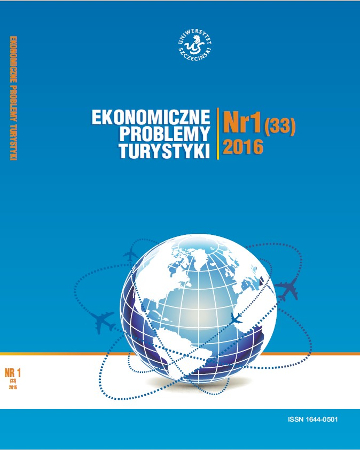
ISSN: 1644-0501
eISSN: 2353-3188
OAI
DOI: 10.18276/ept.2016.1.33-16



Issue archive /
nr 1 (33) 2016
Znaczenie zwierząt w generowaniu ruchu turystycznego i jego organizacji
(The Role of Animals in Travels Creation and Their Logistic)
| Authors: |
Jadwiga
Berbeka
Uniwersytet Ekonomiczny w Krakowie |
| Keywords: | animals tourism travel experience |
| Data publikacji całości: | 2016 |
| Page range: | 12 (199-210) |
Abstract
The complex analysis of travel creation by the willingness to observe or interact with animals was conducted in the paper and also animals’ role in travel logistic was discussed.
As the theoretical background the problem of experience – in reference to the experience economy - was pointed, as the main tourists’ motivation to meet animals. The concept of experiencescape by Mossberg and Actor-Network Theory by Callon i Latour was presented.
The paper has an overview character. The aims of the paper were the analysis of following problems:
– Animals as the motive of the trip;
– Animals as the touristic attraction;
– Animals as the threat of travel; – Animals as a protection in travels; – Animals in transport.
The analysis and assessment of above problems was done on the basis of literature and authors’ observations. The future research was suggested, necessary for tourism management.
Download file
Article file
Bibliography
| 1. | Andersson, T.D., 2007, The Tourist in the Experience Economy, „Scandinavian Journal of Hospitality and Tourism” nr 7, s. 46–58. |
| 2. | Arnould, E.J., Thompson C.J., 2005, Consumer Culture Theory (CCT): Twenty Years of Research, „Journal of Consumer Research”, Vol. 31, nr 4, s. 868–882. |
| 3. | Berbeka, J., 2012a, Charakterystyka popytu w zakresie wybranych form wodnej turystyki przygodowej, w: Popyt turystyczny. Konsumpcja–Segmentacja–Rynki, Zeszyty Naukowe Uniwersytetu Szczecińskiego nr 699, Ekonomiczne Problemy Usług nr 84, s. 497–510. |
| 4. | Berbeka, J., 2011, Turystyka przyjazdowa i jej uwarunkowania w wybranych krajach Bliskiego Wschodu w latach 1990–2007, Zeszyty Naukowe UEK, nr 857, s. 23–36. |
| 5. | Berbeka, J., 2012, Turystyka wolontariuszy na świecie – istota i znaczenie, Zeszyty Naukowe Uniwersytetu Szczecińskiego nr 664, Ekonomiczne Problemy Turystyki nr 2 (18), s. 137–148. |
| 6. | Berbeka, J., Berbeka, K., 2008, Instrumenty ograniczania antropopresji turystyki na region recepcyjny, w: Zrównoważony rozwój turystyki, red. S. Wodejko, SGH, Warszawa, s. 141–152. |
| 7. | Binkhorst, E., Den Dekker, T., 2009, Agenda for Co-Creation Tourism Experience Research, „Journal of Hospitality Marketing & Management”, nr 18, s. 311–327. |
| 8. | Cardall, T.Y., Rosen, P., 2003, Grizzly Bear Attack, „The Journal of Emergency Medicine”; nr 24 (3), s. 331–334. |
| 9. | Durrheim, D. N., Leggat, P. A., 2008, Risk to Tourists Posed by Wild Mammals in South Africa, „Journal of Travel Medicine”, Vol. 6, nr 3, s. 172–179. |
| 10. | Ewert, A., 1989, Models and Theories in Outdoor Adventure Pursuits, w: Outdoor Recreation, Publishing Horizons Inc., Washington, s. 83–102. |
| 11. | Ferreira, S.L.A., Harmse A. C., 2008, The social carrying capacity of Kruger National Park, South Africa: policy and practice, „Tourism Geographies”, nr 1:3, s. 325–342. |
| 12. | Fuglsang, L., Sundbo, J., Sørensen, F., 2011, Dynamics of experience service innovation: innovation as a guided activity – results from a Danish survey, The Service Industries Journal, Vol. 31, nr 5, April 2011, s. 661–677. |
| 13. | Graja-Zwolińska, S., Rączkiewicz, E., Spychała, A., 2013, Fauna sposobem podnoszenia przyrodniczej atrakcyjności turystycznej obszaru, Studia i Materiały CEPL w Rogowie, nr 15, zeszyt 37/4, s. 97–103. |
| 14. | Holbrook M.B., 2006, ROSEPEKICECIVECI versus CCV: The resource-operant, skills-exchanging, performance-experiencing, knowledge-informed, competence-enacting, co-producer-involved, value-emerging, customer-interactive view of marketing versus the concept of customer value: ‘I can get it for you wholesale’, w: The service dominant logic of marketing: Dialog, debate and directions, red. R.F. Lusch, S.L. Vargo, M.E. Sharpe, Armonk, NY, s. 208–223. |
| 15. | Horner, S., Swarbrooke, J., 2005, International cases in tourism management, Elsevier, Norfolk. |
| 16. | Korkman, O., 2006, Customer value formation in practice: A practice–theoretical approach, Series A: 155,: Swedish School of Economics and Business Administration, Helsinki. |
| 17. | Marciszewska, B., 2010, Produkt turystyczny a ekonomia doświadczeń, Wydawnictwo C.H. Beck, Warszawa. |
| 18. | Newsome, D., Rodger, K., 2008, To feed or not to feed: a contentious issue in wildlife tourism, w: Too close for comfort:contentious issues in human-wildlife encounters, red. D. Lunney, A. Munn, W. Meikle, Royal Zoological Society of New South Wales, Mosman, NSW, Australia, s. 255–270. |
| 19. | Mossberg, L., 2007, A Marketing Approach to the Tourist Experience, „Scandinavian Journal of Hospitality and Tourism”, Vol. 7, nr 1, s. 59–74. |
| 20. | Payne, A., Frow, P., Storbacka, K., 2007, Co-Creation of Value: Diagnosing the Brand Relationship Experience, w: Thought Leaders International Conference on Brand Management, presented at Thought Leaders International Conference on Brand Management, Birmingham, England, 24–25 April. |
| 21. | Pine, B.J., Gilmore, J.H., 1999, The experience economy, work is theatre and every business a stage, „Harvard Business School Press”, Boston. |
| 22. | Pine, B.J., Gilmore, J.H., 1998, Welcome To The Experience Economy, Harvard Business Review, July–August, Reprint 98407. |
| 23. | Prahalad, C.K., Ramaswamy, V., 2004, The Future of Competition: Co-creating Unique Value with Customers, Harvard Business School Press, Boston. |
| 24. | Snyder, J., Stonehouse, B., 2007, The growing significance of polar tourism, w: Prospects for Polar Tourism, red. J. Snyder, B. Stonehouse, CABI, Wallingford, s. 3–14. |
| 25. | Stasiak, A., 2013, Produkt turystyczny w gospodarce doświadczeń, „Turyzm”, 23/1. |
| 26. | Stewart, E.J., Draper, D., Johnston, M.E., 2005, A Review of Tourism Research in Polar Region, „Arctic”, vol. 58, nr 4, s. 383–394. |
| 27. | Webster, F.E., 2002, Marketing management in changing times, „Marketing Management”, nr 11, s. 1–17. |
| 28. | Woods, B., 2000, Beauty and the Beast: Preferences for animals in Australia, „The Journal Of Tourism Studies”, vol. 11, nr 2, s. 25–35. |